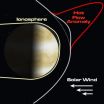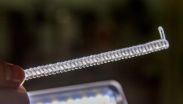(Press-News.org) Researchers recently discovered that a common space weather phenomenon on the outskirts of Earth's magnetic bubble, the magnetosphere, has much larger repercussions for Venus. The giant explosions, called hot flow anomalies, can be so large at Venus that they're bigger than the entire planet and they can happen multiple times a day.
"Not only are they gigantic," said Glyn Collinson, a space scientist at NASA's Goddard Space Flight Center in Greenbelt, Md. "But as Venus doesn't have a magnetic field to protect itself, the hot flow anomalies happen right on top of the planet. They could swallow the planet whole."
Collinson is the first author of a paper on these results that appeared online in the Journal of Geophysical Research in February 2014. The work is based on observations from the European Space Agency's Venus Express. The results show just how large and how frequent this kind of space weather is at Venus.
Earth is protected from the constant streaming solar wind of radiation by its magnetosphere. Venus, however, has no such luck. A barren, inhospitable planet, with an atmosphere so dense that spacecraft landing there are crushed within hours, Venus has no magnetic protection.
Scientists like to compare the two: What happened differently at Earth to make it into the life-supporting planet it is today? What would Earth be like without its magnetic field?
At Earth, hot flow anomalies do not make it inside the magnetosphere, but they release so much energy just outside that the solar wind is deflected, and can be forced to move back toward the sun. Without a magnetosphere, what happens at Venus is very different.
Venus's only protection from the solar wind is the charged outer layer of its atmosphere called the ionosphere. A sensitive pressure balance exists between the ionosphere and the solar wind, a balance easily disrupted by the giant energy rush of a hot flow anomaly. The hot flow anomalies may create dramatic, planet-scale disruptions, possibly sucking the ionosphere up and away from the surface of the planet.
INFORMATION:
NASA researcher finds planet-sized space weather explosions at Venus
2014-02-21
ELSE PRESS RELEASES FROM THIS DATE:
New apps may help detect seizures, treat strokes
2014-02-20
PHILADELPHIA – Two new smart phone applications may help people detect epileptic seizures and get better stroke treatment, according to two studies released today that will be presented at the American Academy of Neurology's 66th Annual Meeting in Philadelphia, April 26 to May 3, 2014.
In the first study, an epilepsy app was designed to help non-doctors determine if a person is having an epileptic seizure.
"It can often be difficult to determine whether someone is having an epileptic seizure," said study author Victor Patterson, MD, a neurologist from Belfast, UK. ...
Western University primatologist teams with international group to save lemurs
2014-02-20
Lemurs, the most endangered mammal group on Earth, represent more than 20 per cent of the world's primates. Native only to Madagascar, more than 90 percent of the species are threatened with extinction.
A Western University primatologist has teamed with 18 lemur conservationists and researchers, many of whom are from Madagascar or have been working there for decades, to devise an action plan to save Madagascar's 101 lemur species. The action plan contains strategies for 30 different priority sites for lemur conservation and aims to help raise funds for individual projects. ...
Vibration energy the secret to self-powered electronics
2014-02-20
MADISON — A multi-university team of engineers has developed what could be a promising solution for charging smartphone batteries on the go — without the need for an electrical cord.
Incorporated directly into a cell phone housing, the team's nanogenerator could harvest and convert vibration energy from a surface, such as the passenger seat of a moving vehicle, into power for the phone. "We believe this development could be a new solution for creating self-charged personal electronics," says Xudong Wang, an assistant professor of materials science and engineering at the ...
Study in mice raises question: Could PTSD involve immune response to stress?
2014-02-20
COLUMBUS, Ohio – Chronic stress that produces inflammation and anxiety in mice appears to prime their immune systems for a prolonged fight, causing the animals to have an excessive reaction to a single acute stressor weeks later, new research suggests.
After the mice recovered from the effects of chronic stress, a single stressful event 24 days later quickly returned them to a chronically stressed state in biological and behavioral terms. Mice that had not experienced the chronic stress were unaffected by the single acute stressor.
The study further showed that immune ...
Nanoscale pillars could radically improve conversion of heat to electricity
2014-02-20
University of Colorado Boulder scientists have found a creative way to radically improve thermoelectric materials, a finding that could one day lead to the development of improved solar panels, more energy-efficient cooling equipment, and even the creation of new devices that could turn the vast amounts of heat wasted at power plants into more electricity.
The technique—building an array of tiny pillars on top of a sheet of thermoelectric material—represents an entirely new way of attacking a century-old problem, said Mahmoud Hussein, an assistant professor of aerospace ...
Developing countries face 'leading medical scourge of developed countries'
2014-02-20
(Garrison, NY) Chronic illness, already a major and expensive problem in developed countries, is rapidly increasing in developing countries, adding to the longstanding burden caused by high rates of infectious diseases. However, poor countries will not be able to afford the costly medical technologies that wealthy countries use to treat chronic conditions, including heart disease, stroke, cancer, pulmonary disease, and diabetes, writes Daniel Callahan, cofounder of The Hastings Center.
Callahan examines this trend and concludes that it calls for a new, more economically ...
Long-term daily multivitamin supplement use decreases cataract risk in men
2014-02-20
SAN FRANCISCO – Feb. 20, 2014 – Long-term daily multivitamin supplement use may lower cataract risk in men, according to a study of nearly 15,000 male physicians published this month in Ophthalmology, the journal of the American Academy of Ophthalmology.
Past observational studies have indicated a relationship between nutritional supplement use and eye health. However, randomized trial data on the effects of long-term multivitamin supplement use and risk of eye diseases are limited and, in some cases, non-existent. To address this, researchers based at Brigham and Women's ...
Extreme weather decides distribution of insects
2014-02-20
As climate change is progressing, the temperature of our planet increases. This is particularly important for the large group of animals that are cold-blooded (ectothermic), including insects. Their body temperature is ultimately determined by the ambient temperature, and the same therefore applies to the speed and efficiency of their vital biological processes.
But is it changes in average temperature or frequency of extreme temperature conditions that have the greatest impact on species distribution? This was the questions that a group of Danish and Australian researchers ...
UT Dallas-led team makes powerful muscles from fishing line and sewing thread
2014-02-20
An international team led by The University of Texas at Dallas has discovered that ordinary fishing line and sewing thread can be cheaply converted to powerful artificial muscles.
The new muscles can lift a hundred times more weight and generate a hundred times higher mechanical power than the same length and weight of human muscle. Per weight, they can generate 7.1 horsepower per kilogram, about the same mechanical power as a jet engine.
In a paper published Feb. 21 in the journal Science, researchers explain that the powerful muscles are produced by twisting and ...
Bioengineered growth factors lead to better wound healing
2014-02-20
When we are wounded, our bodies naturally begin a process of repair of the damaged tissue. This process is mediated by biological molecules called growth factors, which are proteins that occur naturally in our cells and guide processes ranging from embryonic development to healing. Given their regenerative role in the body, growth factors have been investigated for use in drugs but with limited success. Publishing in Science, an EPFL group has used bioengineering to significantly improve the efficacy of clinical growth factors in the context of soft tissue and bone repair, ...



